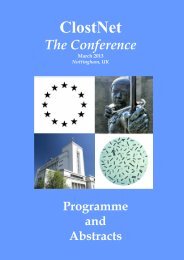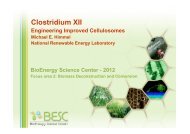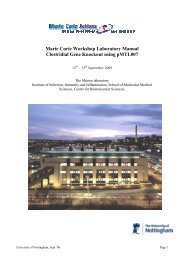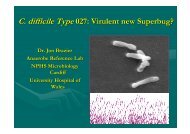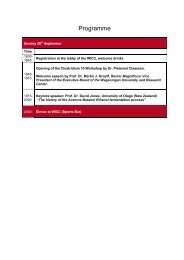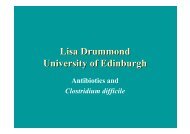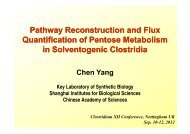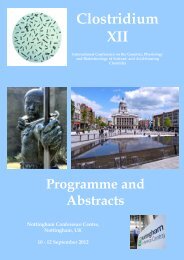abstract book - Clostridia
abstract book - Clostridia
abstract book - Clostridia
You also want an ePaper? Increase the reach of your titles
YUMPU automatically turns print PDFs into web optimized ePapers that Google loves.
DETECTION OF CLOSTRIDIUM BOTULINUM NEUROTOXIN GENES<br />
(BONT) A, B, E AND F WITH REAL-TIME-PCR<br />
U. Messelhäusser, R. Zucker, W. Kleih, C. Höller, U. Busch<br />
Bavarian Health and Food Safety Authority, 85764 Oberschleißheim,<br />
Germany<br />
Intoxications with C. botulinum toxins belong also in Germany to the<br />
rare occurring food-poisonings; the mortality, however, is very high. In<br />
the last years the risk for the consumer´s health is mainly due to not<br />
commercially produced food cans or salted bacon. Because of the<br />
difficult and time-consuming cultural detection of C. botulinum, PCR<br />
methods to screen for the toxin genes A, B, E and F, which are relevant<br />
in human medicine, have been used increasingly during the last years.<br />
These comprised mostly conventional PCR methods which are not so<br />
efficient to screen large numbers of samples. Therefore we designed<br />
for the C. botulinum-detection in our routine laboratory two probe-based<br />
real-time-PCR-assays, one triplex-PCR-assay for the detection of<br />
BONT A and B in combination with an Internal Amplification Control<br />
(IAC) and one duplex-system for the detection of BONT E and F, both<br />
based on the Taqman-technology. As IAC we used the pUC 19<br />
plasmid. Both assays were tested for specifity and sensitivity with pure<br />
cultures first and then with artificially contaminated food samples (meat,<br />
fish and honey) after enrichment. The sensitivity with pure cultures was<br />
10 cfu/ml for all four toxin genes. Food samples contaminated with<br />
10 cfu/g, were reliably detected as positive with real-time-PCR after<br />
enrichment. Subsequently we checked 147 routine samples with our<br />
real-time-PCR-systems, the conventional PCR-system of Lindström et<br />
al., 2002 and the cultural method in parallel. We examinated mainly<br />
food samples (honey, carps, canned meat and vegetables), but also<br />
animal feeding stuff and environmental samples. Six samples were<br />
positive with the real-time-PCR and the convential PCR-system of<br />
Lindström et al., 2002 (five samples for BONT B and one sample for<br />
BONT E), but only five samples were positive with the cultural method.<br />
The results of our examinations indicates, that the two real-time-PCRassays<br />
are suitable in a routine laboratory for a fast screening for the<br />
presence of Clostridium botulinum type A, B, E and F in food samples.<br />
43



